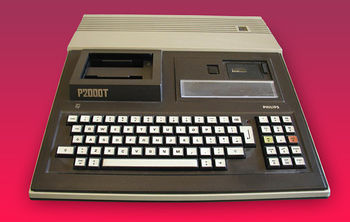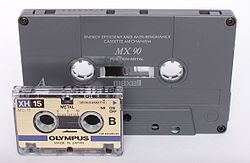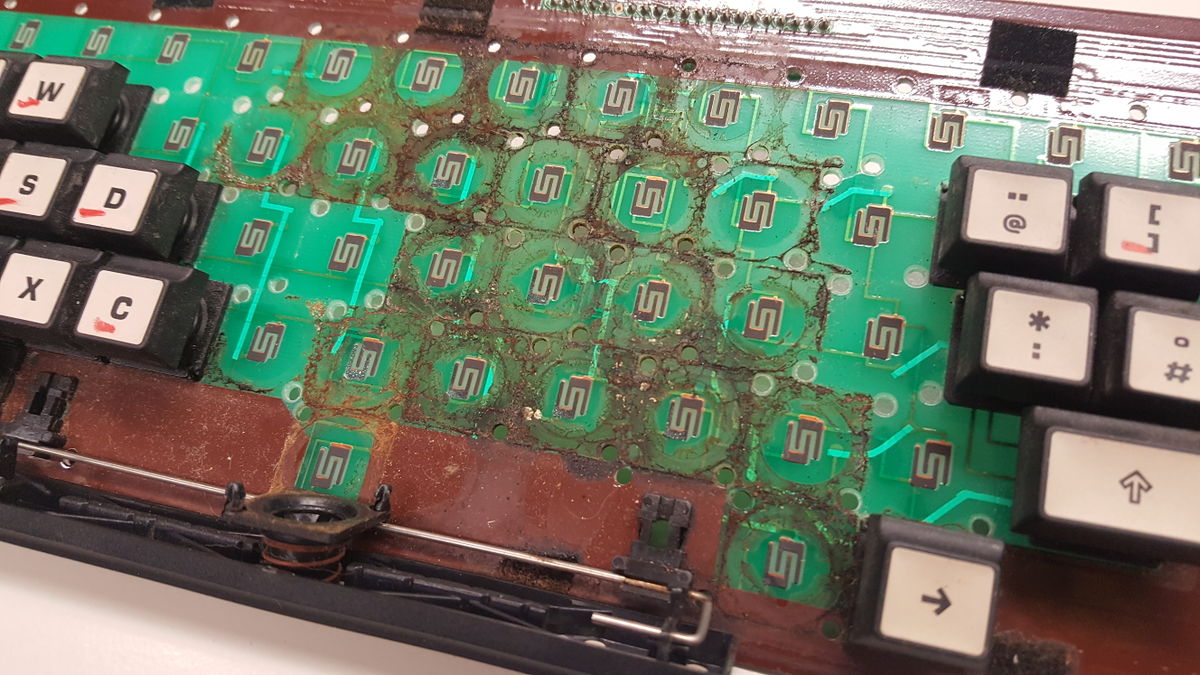P2000T
| Project P2000T | |
|---|---|

| |
| A new addition to my collection, to cleanup and get working | |
| Status | In progress |
| Contact | Mahjongg |
| Last Update | 2017-09-25 |
12 September, 2017 received a P2000T in box
The Philips P200T I received from Benadski as a donation, came in a plain looking cardboard with large brown spill marks, it seemed sometime in the past had spilled a lot of coffee (or something like that) over it, and the computer looked like a mess, so I disassembled the computers, in an an attempt to estimate the damage the coffee had done. Remarkably the main board was as new, but the keyboard PCB wasn't as lucky, as the coffee had spilled all over it. After cleaning it thoroughly I assembled it, and took it home to test if it was working, which it did, but unfortunately I couldn't test if there was damage to the keyboard!

It also did not come with a manual, or anything else, beyond a power cable. Especially unfortunately was that the essential BASIC cartridge was missing, as was the transparent cover over the what I presume was a place to stick some indexing card or maybe just a logo, as can be seen in the project picture on the right here. Without the BASIC cartridge the machine is essentially non operational. It does have a 4K monitor ROM chip, but that contains just a kind of "BIOS" routines like memory testing, and serial printer and cassette drivers. It has no user interfacing code what so ever, not even a debug monitor. when you turn on such a P2000T you only get this screen, (see picture at the right) and a loud beep through the TV speaker, so at least it seems the system is still working:

There is no interaction at all. I noticed that when pressing the "down arrow key" an uppercase L started blinking somewhere on the top of the screen, no idea what that is about! I have read that the machine would automatically start loading a tape, but that wasn't noticeable on my machine, perhaps because it also came without any cassette tape. Note that the P2000T uses a very unusual tape system in the form of small dictaphone cassettes, (microcassette) much smaller than normal audio cassette tapes. Philips used specific hardware to get a baud rate of 6000 bits per second, using FM encoding, which was quite fast for the time, this was possible by using a directly coupled analog circuitry to the microcassette, instead of using a generic audio cassette and its limitations.
The P2000T was quite expensive when it was launched, about 3000 Dutch guilders, (equivalent to €2725 in 2015) and it didn't offer much for that money, just a 2.5Mhz Z80, (slower even than the at 3.25MHz clocked ZX81) with 4K RAM (expandable to 16K) and a Videotex compatible 40x24 screen with 8 colours. Sound was just a 1 channel speaker. outside of schools (it got a part of the 100-school project, that was actually won by Aster Computer which was a real Dutch computer, unlike the P2000T which was designed in Austria) it did not seem to have had much success, but at least it had colour through its SAA5050 and SAA5020 Teletext chipset, which Philips borrowed from its TV designs, so despite it not having any high resolution graphics, nor even re-programmable characters, it still has a small collection of games.
Unfortunately without a BASIC cartridge I cannot even test of the keyboard has survived the coffee disaster, I have looked under one of the keys (which are individually click mounted to the keyboard PCB, and use the rubber dome technique with a carbon pad) and saw some evidence of the sticky dried up liquid, but in this case it did not cover the keypad fingers, but other keys might not have been be so lucky. So I need to test all the keys to see if any of them has coffee damage.
My next task will be to somehow get or make a BASIC cartridge, so I can at least test if the keyboard is in working order. I also will need a copy of the user manual, which is not available online (and which I have read is of atrocious quality anyway, not even detailing the memory map, for example) but I still think I need it. Perhaps I can lend one from awesome space and photo copy it, Perhaps they also have a BASIC cartridge from which I can read out the ROM's, and create my own copy. I will also want to acquire at least one microcassette tape, although you cannot get tape files for this system, for some reason, so its of little use beyond saving small BASIC programs to see if the tape system still works.
23 September, 2017 I have a 16K BASIC cartridge!
I was just leaving Revspace (to get my logic probe) to go to Awesome Space in Utrecht to do some more work on the space invaders console there, when I ran into Benadski, who offered me the BASIC interpreter cartridge, a gracious donation of Hewlett of the circuits online forum, see: https://www.circuitsonline.net/forum/view/135755/9 Obviously I'm very pleased with it, as without one a P2000T is a good as useless (except when you have loadable tapes, which I have heard will auto load).
I can report that the cartridge works, and has revision 1.1 of 16K Microsoft BASIC. I had also brought the same cartridge which I borrowed from Awesome space, just in case this one didn't work, but that one also did, but by the was a revision 1.0 version, so I don't need it after all.
I tested all the keyboard keys, but 2/3 of them are not working! So I plan to remove all keys (except the space bar, which is one of the working keys) to clean the PCB underneath them.
24 September, 2017 Keyboard is a mess!
I started replacing the matrix pull-ups with weaker ones, which meant desoldering a 10x4K7 resistor network, (with hot air) and after removing the solder from the holes (which was difficult) I soldered in ten loose 10K resistors, and connected their tops together and to pin-1 of the resistor network, to replace the ten 4K7 resistors with 10K ones. In the past this has helped with troublesome keyboards, as their keypads do not make as good contact as before.
After that I started systematically removing keycaps, starting from the top row. Unfortunately after removing a few keypads it became obvious that the coffee had left a right mess around the keypads, see this picture and shiver!
That didn't look good at all! After cleaning out the mess with keyboard cleaner (windex) and isopropranol (alcohol) I tested a few connections, and soon discovered there were traces that were in parts bad, parts of the draces had become discolored and dark, and there it seems they had "rotted through"! at a dozen places these dark spots were visible, and all of them seemed to be a disconnect! I have started to repair these, but it is slow going, and I will not finish it today!
I have found a technical reference document, and it shows the P2000T uses a BCD encoder (one out of ten), and eight inputs, (an eight by ten matrix, good for eighty keys, but the P2000T has only 66 keys, so at least 6 locations in the matrix are empty, or 7 if the two shift keys are wired in parallel) but nowhere does it say which key belongs to which matrix position. So that doesn't really help me much.
25 September, 2017 Found the keyboard matrix layout
The matrix is as follows: Keyboard layout
Y \ X0 1 2 3 4 5 6 7
0 LEFT 6 up Q 3 5 7 4
1 TAB H Z S D G J F
2 . * SPACE 00 * 0 * # DOWN , RIGHT
3 SHLOCK N < X C B M V
4 CODE Y A W E T U R
5 CLRLN 9 + * - * BACKSP 0 1 -
6 9 * O 8 * 7 * ENTER P 8 @
7 3 * . 2 * 1 * -> / K 2
8 6 * L 5 * 4 * 1/4 ; I :
9 LSHIFT RSHIFT
Keys marked with an asterix (*) are on the numeric keypad
